Winter and early spring is often the best time for tracking down some of Britain's scarcer avian visitors, and among the most anticipated is Water Pipit Anthus spinoletta. This connoisseur's 'little brown job' winters south of a line between Fort William and Loch Ness, though by far the majority are in England and Wales. Indeed clusters around the inner Severn Estuary, the Dorset and Hampshire coastline, the outer Thames estuary complex and East Anglian coast mean most are to be found in southern England. It seemingly numbers no more than about 200 individuals, according to the British Trust for Ornithology's Bird Atlas 2007-11.
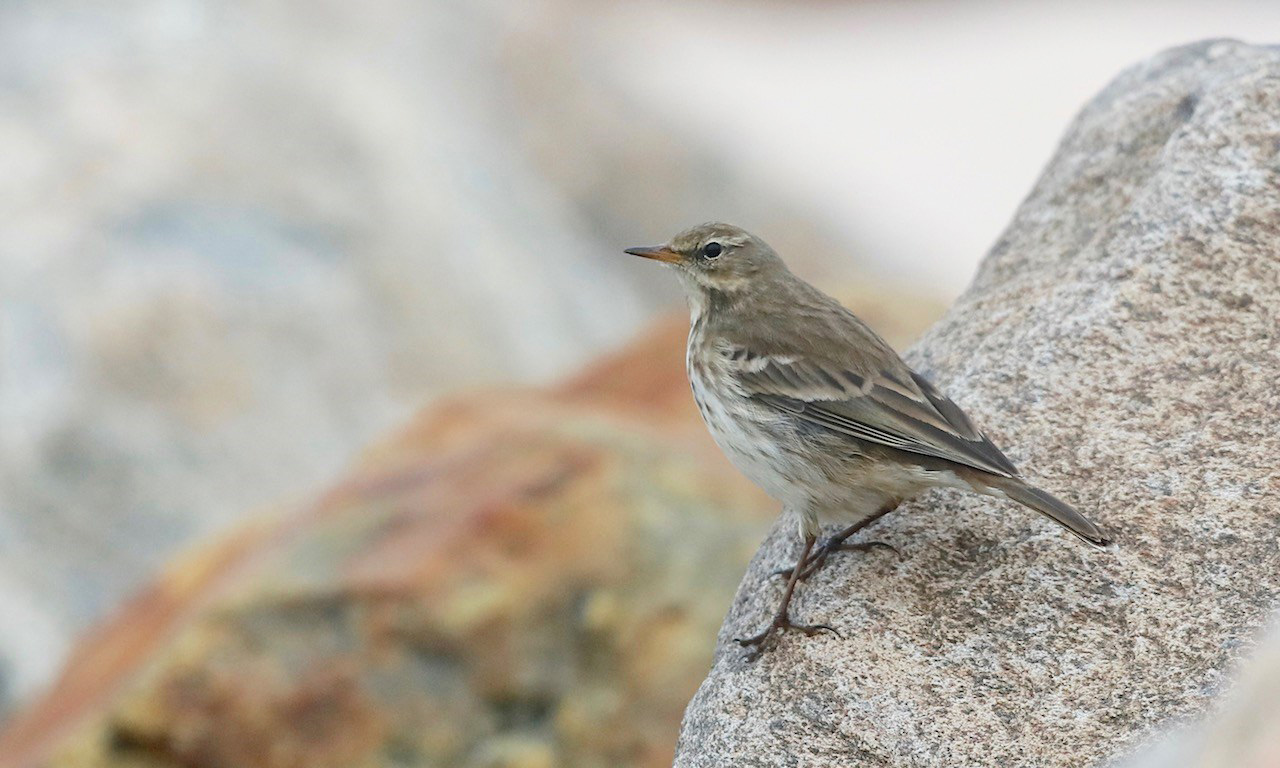
Though similar to both forms of Rock Pipit, the cleaner, more contrasting underparts, sparser streaking, warmer rump (just visible) and pale wing-bars reveal this bird’s true identity as a Water Pipit, and it should show very white outer tail feathers when it takes flight (Morten Scheller Jensen).
Water Pipit can be something of an early spring migrant, meaning birders can see its drab but finely detailed winter plumage already changing into the subtly gaudy pink, blue-grey and white of its summer garb while on passage. This can lead to confusion with Rock Pipits of the Fennoscandian subspecies littoralis, which are also tinged pink, but are darker with a more heavily streaked breast and a more uniform grey-blue on the upperparts.
Water Pipit in winter and summer has bright white outer tail feathers and more prominent white wing-bars than Rock Pipit, though the tails of some Rock Pipits can look similar in strong light. Otherwise, in winter Water Pipit is paler on the underparts than Rock, with much less buff tingeing on the flanks, a warm brown rather than grey-brown rump, and a more greyish head and back with a prominent white supercilium. Spring and summer birds also have a fairly obvious demarcation between the blue-grey neck and warmer brown back which has barely noticeable streaking.
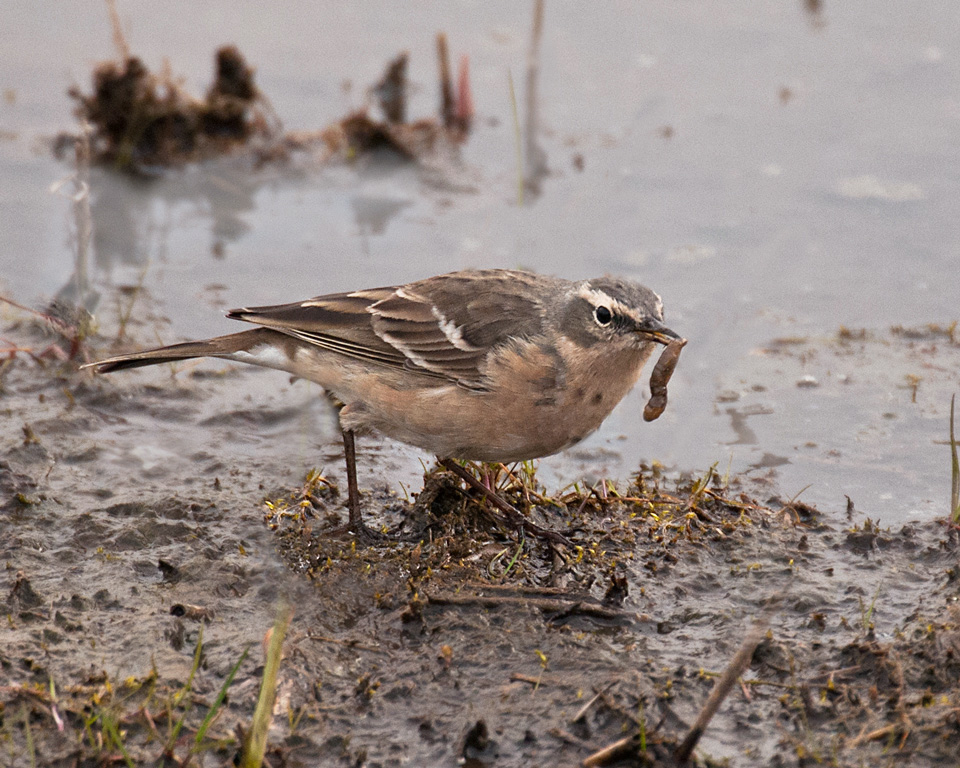
This spring-plumaged Water Pipit shows demarcation between the greyish head and more brownish back; other key features include the strong white supercilium and the lack of flank streaking (Pixellence).
Three-way pipit
Variation is apparent among Water Pipit's recognised subspecies, one of which – the Turkish, Caucasian and Iranian breeding subspecies coutellii – has been proposed as a potential split. This form has buff-tinged underparts with paler, more diffuse markings and more contrast on the upperparts making these appear more streaked in comparison to nominate spinoletta, and is a warmer pink on its breast in breeding plumage. A third subspecies, blakistoni, is found in Central Asia and China; it is even paler and less heavily streaked than coutellii, but often indistinguishable in winter.
Both Buff-bellied and Rock Pipits were once lumped with Water Pipit as one polytypic species. They were split into three variable species by most authorities in the 1980s, including the British Ornithologists' Union's Records Committee in 1986. While molecular science isn't everything, there is around 1.2 per cent genetic difference between Rock and Water Pipits, a little less than the oft-assumed 2 per cent 'rule of thumb', and there is still residual doubt among a few taxonomists over whether they should be split. However, although there is no overlap in summer ranges, their breeding habitats are different, and there are clear distinctions in plumage (less so in their vocalisations). One thing the genetics do seem to show is that Meadow Pipit shares a common ancestor with both Rock and Water Pipits, whereas Buff-bellied has been separated for longer.
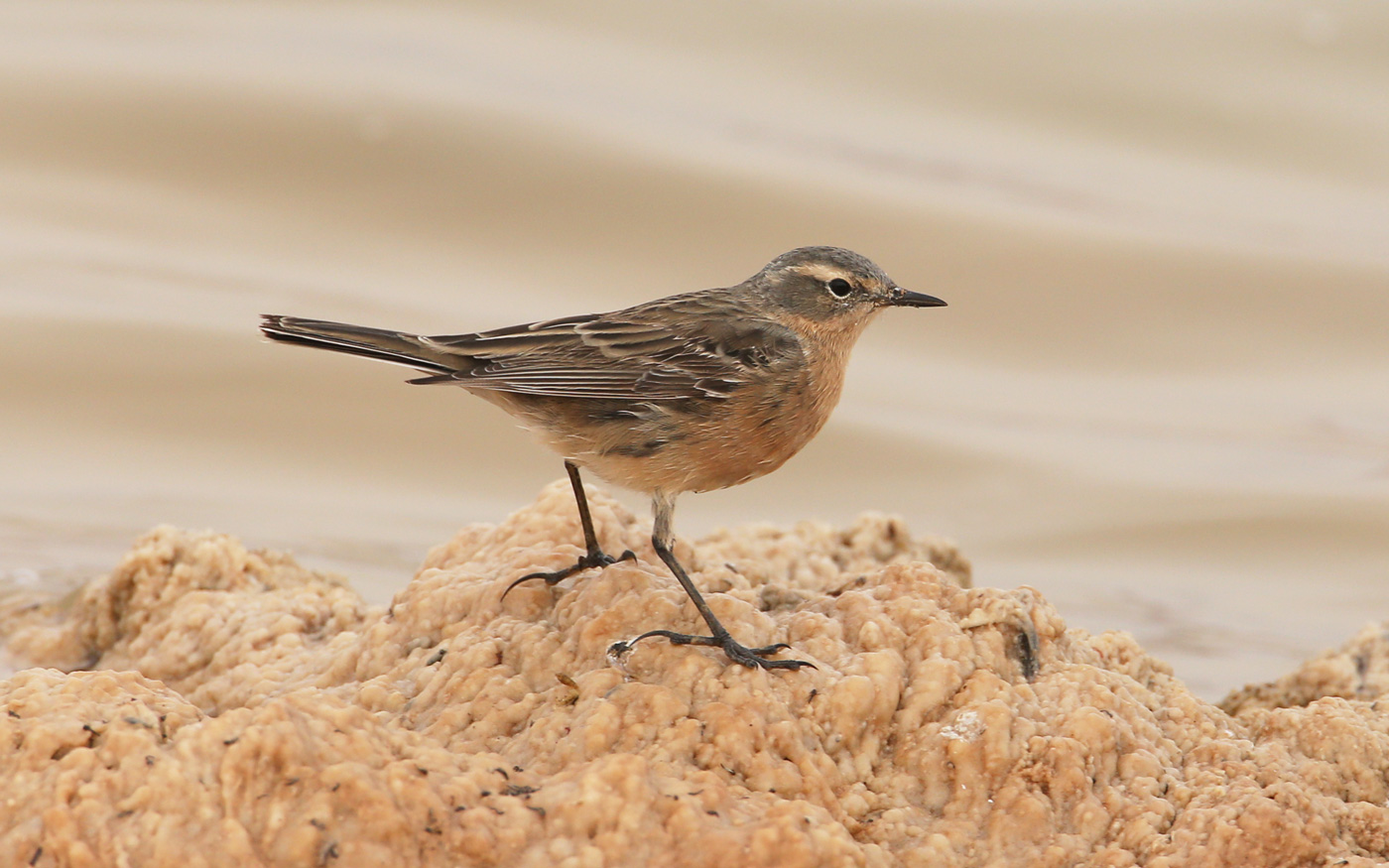
A Water Pipit of the Caucasian subspecies coutellii, photographed on spring passage in Israel in March (Steve Arlow).
The calls of Water and Rock Pipit are very similar, and can only really be told by ear with experience in still or close conditions. Water Pipit's call can be rendered as a high-pitched, up-slurred viiisst, perhaps a little smoother than Rock Pipit; it is often given as the bird is flushed from a distance (it is usually not as approachable as many Rock Pipits can be, and tends to fly further on flushing).
In Britain, the species favours freshwater habitats over the shorelines of its closest congener, foraging on flooded meadows and inland marshes, though it can tolerate brackish estuarine conditions such as those found on the outer Thames and outer Severn, where it mixes quite freely with Rock and Meadow Pipits.
On its breeding territories, the nominate form is a species of the Central European mountains, frequenting slopes with short grass or heather, or wet meadows and streams above the treeline. The species can tolerate permanent snow cover, but maintains its summer altitudinal range at between 615 to 3,150 m, varying this choice between ranges, occurring at the lower height in the Bayern hills of Germany and the highest level in the Balkans and Russia.
Paired for life?
Water Pipit is largely monogamous, with pair bonds often extending into winter when the male and female can loosely associate on seasonal territories, using contact calls and following each other in flight, though it is not known how long such bonds last. Conversely, when second broods occur in summer, a different partner is often chosen as parent.
Initial pair formation occurs in flocks before arrival on breeding territories, though sometimes only after males have secured nesting areas. Despite this general loyalty, studies have shown that 12.4 per cent of nests have chicks resulting from 'extra-pair paternity', though where this occurs it is normally facilitated by overlapping territories or compact communal foraging areas.
Display can involve singing from a bush or in flight, with the birds ascending up to 30 m into the air on shallow wingbeats, then circling or gliding over the territory, and finally descending with spread wings and tail somewhat in the manner of a Tree Pipit; display may also occur from tree to tree, on occasion. Singing may continue after landing, mostly from vegetation but rarely beneath.
Chases within or around roosts are viewed as sexual bonding behaviour, while on the ground sideways 'dancing steps' are seen, sometimes with bill-to-bill contact. The deal settled, a hole in a pool or river bank or under thick vegetation is selected, in which a round cup of grass and leaves is constructed, lined with moss and fine hairs, and generally facing east-north-east to shelter it from the elements and enable it to warm up in the morning; into this is deposited a clutch of four-six mottled brown, grey-white eggs.
A fortnight later, the altricial (or under-developed) young hatch and are fed by both parents for another fortnight or so, until they are ready to form loose and nomadic juvenile flocks in midsummer. These are joined by second broods and then moulting adults for a few weeks into September. Fledglings are usually fully independent after 30 days or so.
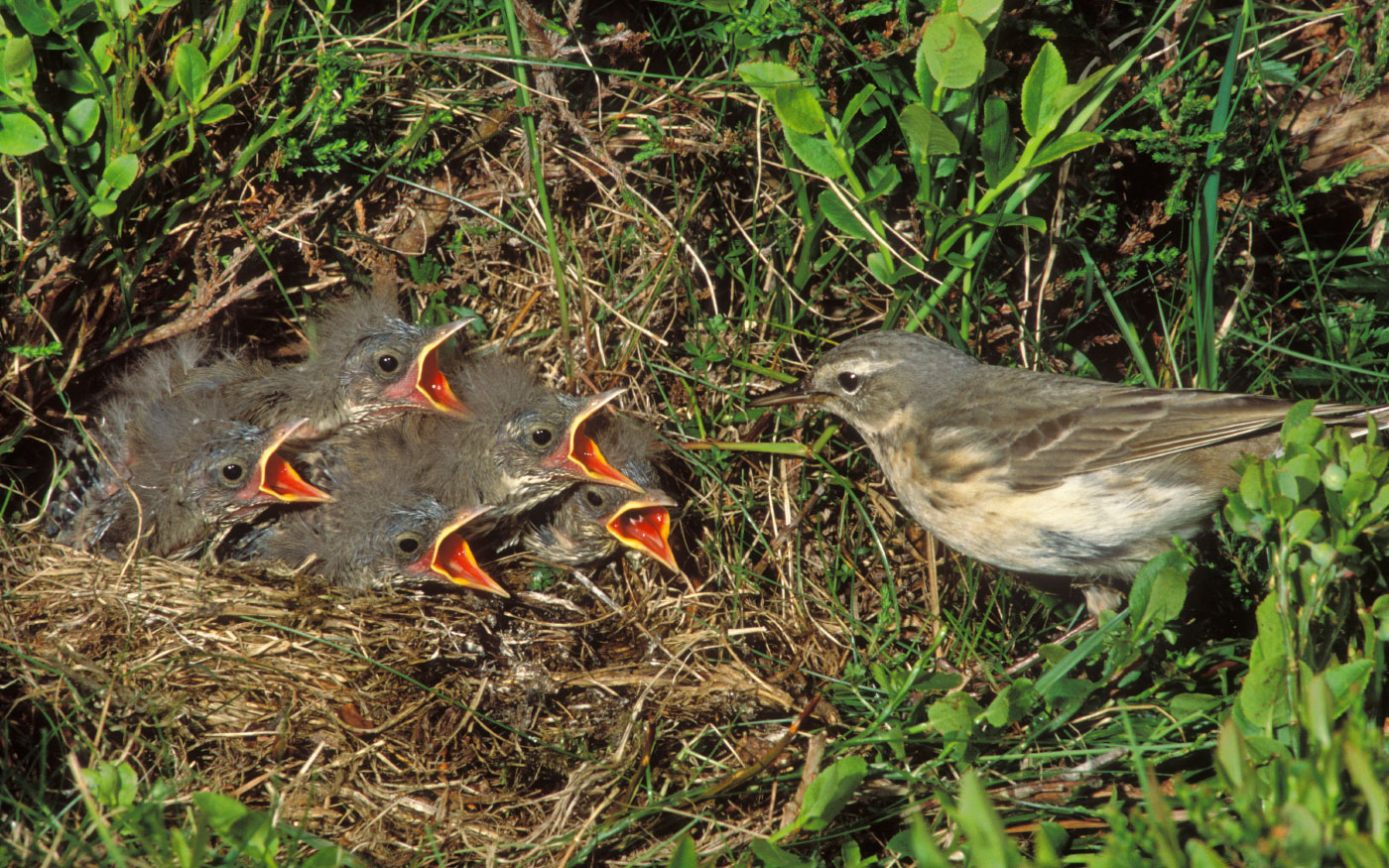
Water Pipit brings up a brood of between four to six chicks. This nest was in the French Pyrenees in July 2005 (Dave Watts).
Like many other passerines, Water Pipits are fastidious about cleanliness, sometimes bathing in water, but otherwise using sand and dust. They can be seen prostrating themselves in strong sunlight and 'anting', during which they pick up ants and rub them on their feathers, presumably using the exuded formic acid in the constant battle against parasites, fungus and bacteria, though this behaviour may also make the ants more palatable to eat.
A consequence of its chosen habitats is Water Pipit's catholic diet, ranging from aphids to small crabs, and taking in small molluscs, worms, crickets and beetles, and even berries, weed seeds and algae (this last item can account for up to 75 per cent of its diet in the Krkonoše Mountains of the Czech Republic and Poland).
Freezing and feigning
The major predators of Water Pipit in Britain are Common Kestrel and Eurasian Sparrowhawk, and the species has been seen to freeze in their presence, or even hide behind rocks. Parent birds have also been witnessed giving a 'disablement-type distraction-lure display' – that is, feigning a broken wing and luring potential predators away from the nest.
Alarm calls will make a flock take off immediately and land in the nearest available bush or tree, adopting alert postures lasting for several minutes. Despite this apparent timidity, Water Pipits have been observed mobbing and chasing Golden Eagle, Common Cuckoo and Nutcracker, as well as the more well-matched Northern Wheatear and Eurasian Skylark. Water Pipit is also a host to brood parasitism, though the Common Cuckoo egg strain involved is more generally adapted to all European Anthus pipits rather than a single species.
Outside the breeding season, Water Pipit can be either a loner or gregarious, though the latter behaviour is more prevalent on migration. Larger flocks of up to 130 individuals have been noted near breeding territories in late summer, though these quickly disperse.
In Britain, key wintering sites are returned to on an annual basis, but the implied territoriality is loose, with birds mingling at richer food sources but sometimes fighting in more prey-depauperate areas; congeners such as Meadow and Rock Pipits may also be the subject of antagonistic forays. Outside of the breeding season, roosts are usually communal, assembled in thickets and within about four miles of the feeding areas, and can be also shared with both Reed Buntings and Pied Wagtails.
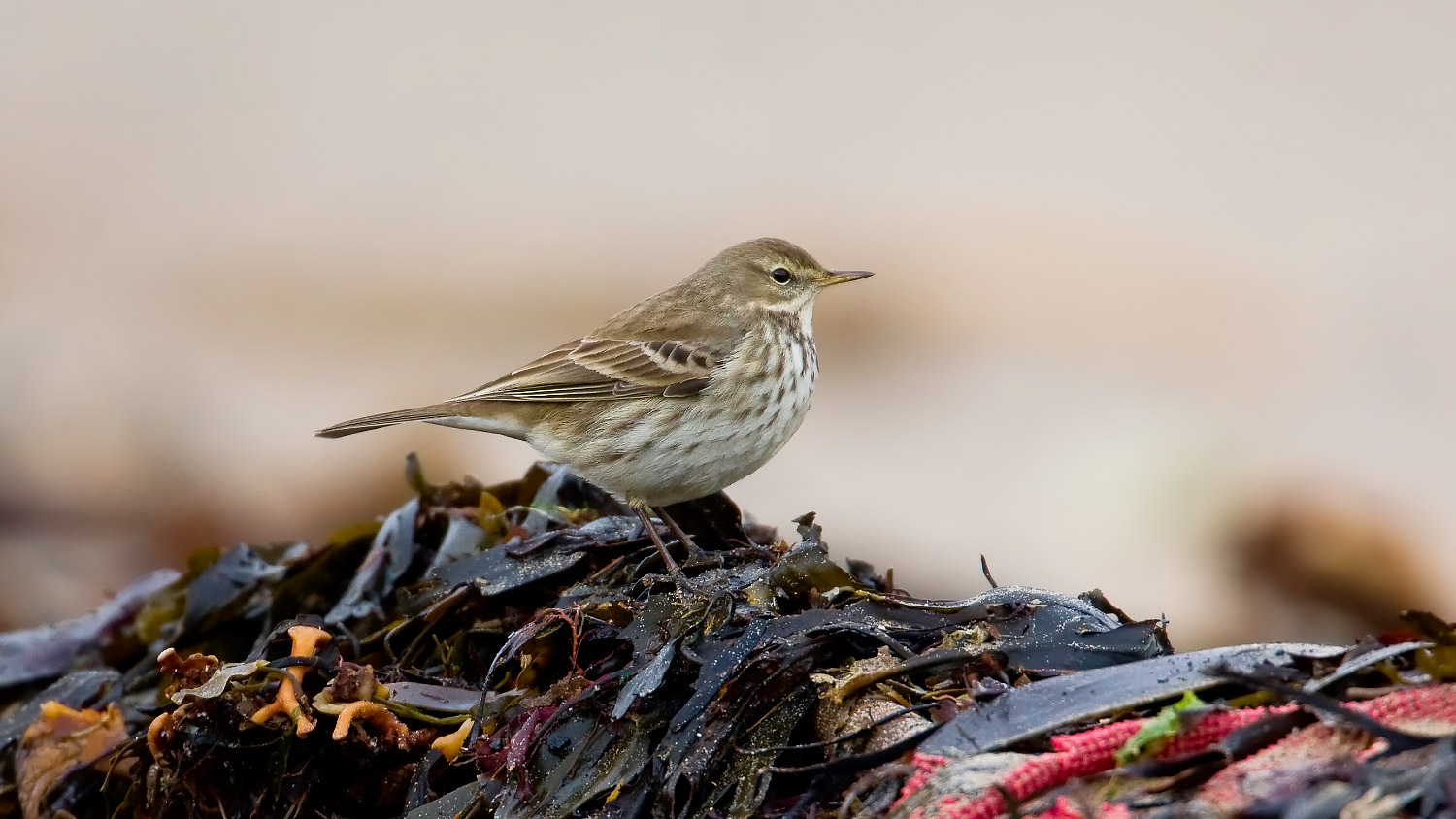
Despite its reputation as a species largely associated with freshwater habitats, Water Pipit can certainly sometimes be found alongside tidal river estuaries, by brackish water and – as here, on St Mary’s Island, Northumberland, in January 2009 – actually foraging on the shoreline, in typical Rock Pipit habitat (John Malloy).
Water Pipit is as much an altitudinal migrant as it is a geographical one, and seems to be drawn by appropriate habitat as much as the impulse to move on. It partly lingers in the Pyrenees and northern Spanish mountains, the Alps and Appenines, but is a summer visitor only to the Carpathians and Balkans.
It winters in south-east Europe, North Africa, Iberia and western Europe north to Denmark and west to Britain, but is largely absent from Ireland. This means that a fair number of individuals move north-west or west, an unusual strategy, but one which can perhaps be explained by the milder climate of coastal Europe, as well as the presence of a lot of lowland flooded meadows and marshes. The two eastern subspecies have a more traditional southerly impetus to their migrations, but with only blakistoni being a long-distance migrant and coutellii making movements comparable to spinoletta, wintering in the Nile Valley and the Middle and Near East.
In Britain, the good thing about Water Pipit's loyalty to certain habitats at certain sites means that you can be fairly sure of seeing one in winter if you go to the right place. Despite this, the species can be elusive and cryptic, keeping to ground level and feeding among seaweed and grass. It is usually flighty and aware of even its distant surroundings – so good luck with getting close to one!
References
Alström, P, and Mild, K. 2003. Pipits and Wagtails of Europe, Asia and North America. Christopher Helm, London.
Balmer, D, Gillings, S, Caffrey, B, Swann, B, Downie, I, and Fuller, R. 2013. Bird Atlas 2007-11. BTO, Thetford.
Bureš, S, Nádvorník, P, and Saetre, G-P. 2002. Hybridization and apparent hybridization between Meadow Pipit (Anthus pratensis) and Water Pipit (A spinoletta). Hereditas 136: 254-256.
Knox, A. 1988. Taxonomy of the Rock/Water Pipit superspecies Anthus petrosus, spinoletta and rubescens. British Birds 81: 206-211.
Rauter, C M, Reyer, H-U, and Bollmann, K. 2003. Selection through predation, snowfall and microclimate on nest-site preferences in the Water Pipit Anthus spinoletta. Ibis 144: 433-444.
Rehsteiner, U, Geisser, H, and Reyer, H-U. 1998. Singing and mating success in water pipits: one specific song element makes all the difference. Animal Behavior 55: 1471-1481.
Reyer, H-U, Bollmann, K, Schläpfer, A R, Schymainda, A, and Klecack, G. 1997. Ecological determinants of extrapair fertilizations and egg dumping in alpine water pipits (Anthus spinoletta). Behavioral Ecology 8: 534-543.
Snow, D W, and Perrins, C M. 1998. BWPi. BirdGuides, London.
Soler, J J, Vivaldi, M M, and Møller, A P. 2009. Geographic distribution of suitable hosts explains the evolution of specialized gentes in the European cuckoo Cuculus canorus. BMC Evolutionary Biology 9: 1-10.
Voelker, G. 1998. Molecular evolutionary relationships in the avian genus Anthus (pipits: Motacillidae). Molecular Phylogenetics and Evolution 11: 84-94.
- This article was originally published in the March 2018 issue of Birdwatch magazine.



